Critical Analysis: Nursing Students' Peer Learning Research Paper
VerifiedAdded on 2022/09/28
|12
|3506
|20
Report
AI Summary
This report presents a critical appraisal of a qualitative research paper by Carlson et al. (2019) that explores nursing students' perceptions of peer learning through cross-cultural student-led webinars. The appraisal utilizes the COREQ checklist to evaluate the study's research team and reflexivity, study design, analysis, and findings. The report examines the significance of the research problem in healthcare, focusing on cultural competency and peer learning's role in addressing health disparities. It analyzes the study's methodology, including participant selection, data collection methods (reflective writing and focus group interviews), and data analysis techniques (thematic analysis). The report identifies strengths, such as the use of participant quotations, and weaknesses, including the small sample size, gender inequality among participants, and lack of pilot testing for interview questions. The critical analysis assesses the study's overall quality, implications for clinical practice, and suggestions for further research, concluding with the generalizability of the research paper's findings.
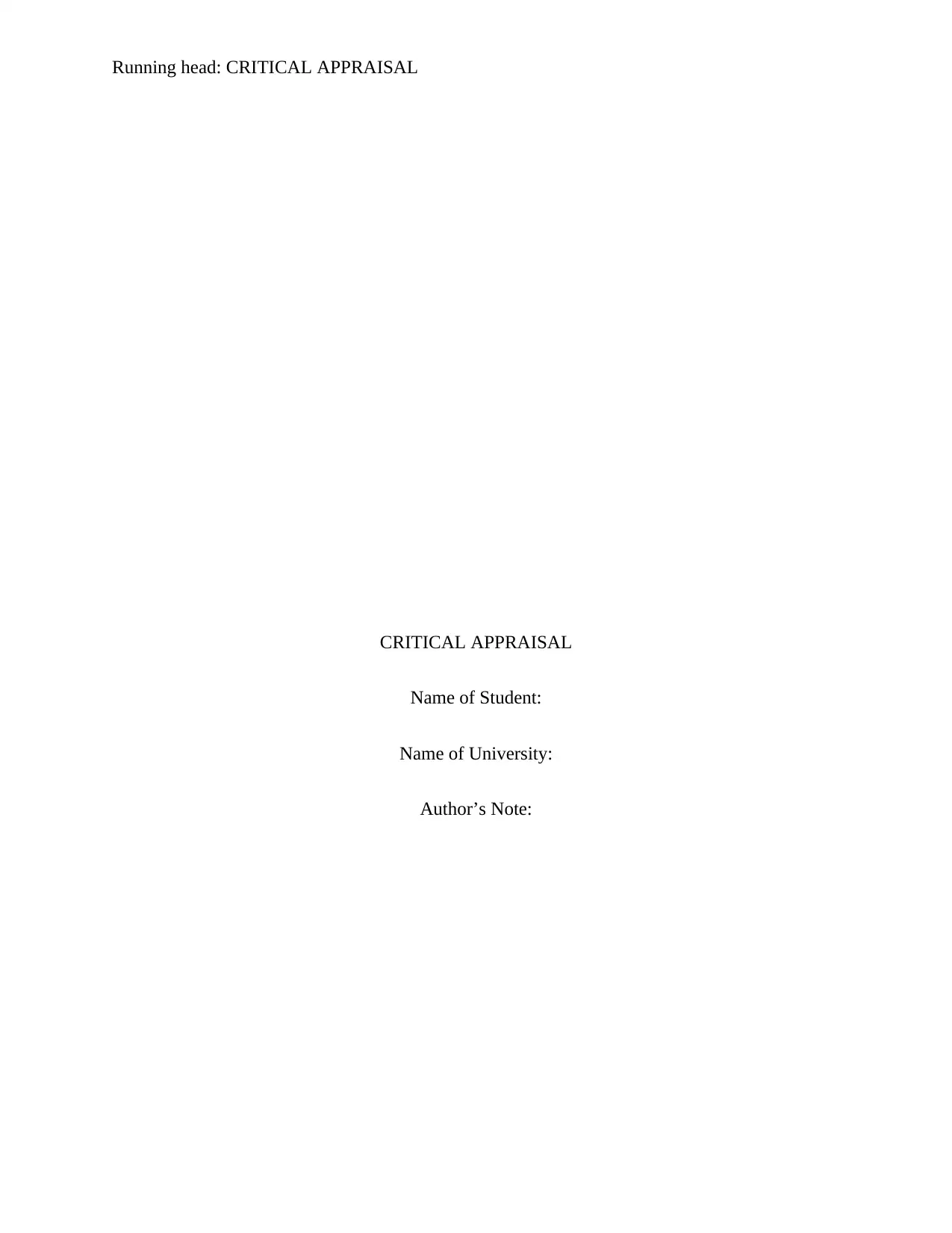
Running head: CRITICAL APPRAISAL
CRITICAL APPRAISAL
Name of Student:
Name of University:
Author’s Note:
CRITICAL APPRAISAL
Name of Student:
Name of University:
Author’s Note:
Paraphrase This Document
Need a fresh take? Get an instant paraphrase of this document with our AI Paraphraser
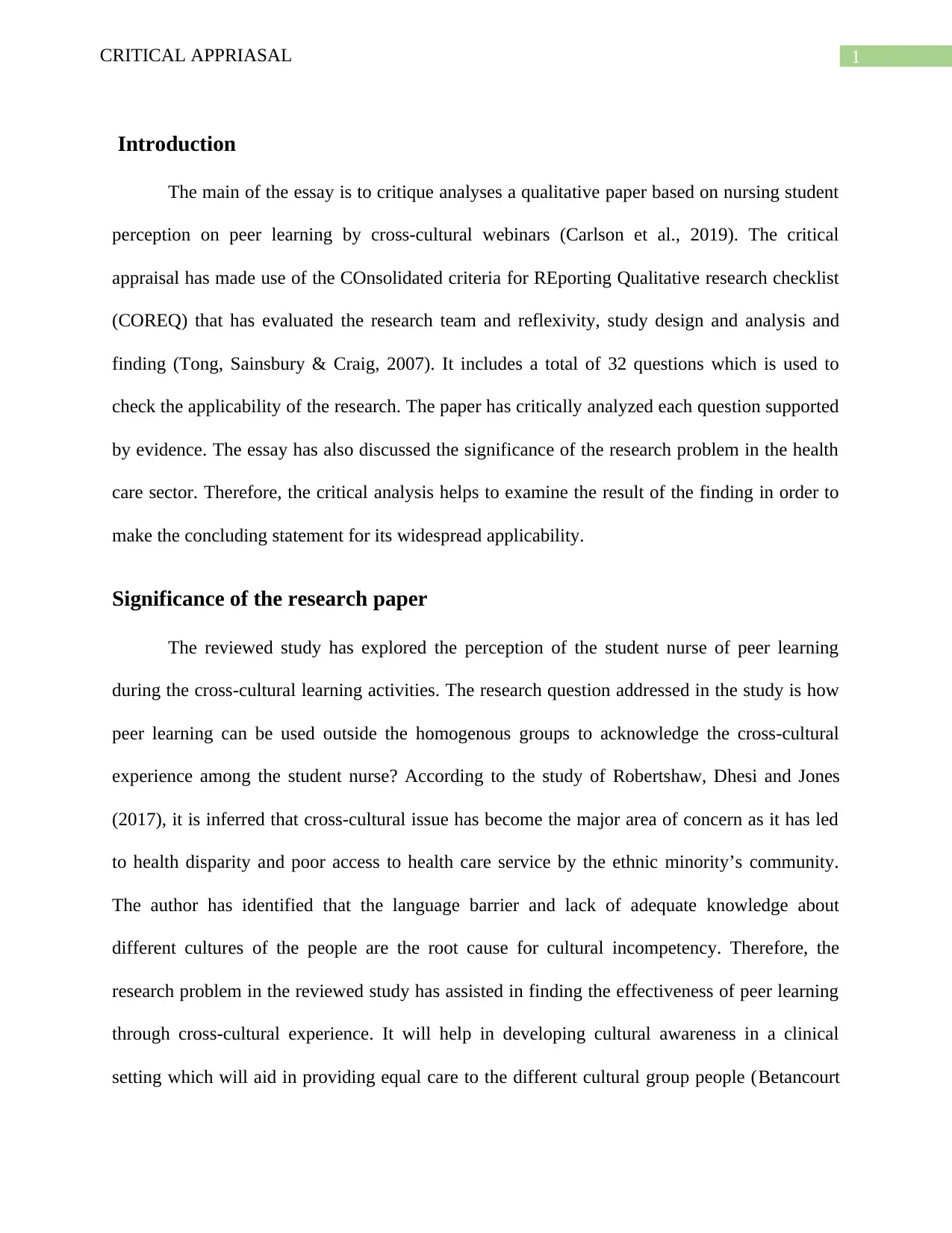
1CRITICAL APPRIASAL
Introduction
The main of the essay is to critique analyses a qualitative paper based on nursing student
perception on peer learning by cross-cultural webinars (Carlson et al., 2019). The critical
appraisal has made use of the COnsolidated criteria for REporting Qualitative research checklist
(COREQ) that has evaluated the research team and reflexivity, study design and analysis and
finding (Tong, Sainsbury & Craig, 2007). It includes a total of 32 questions which is used to
check the applicability of the research. The paper has critically analyzed each question supported
by evidence. The essay has also discussed the significance of the research problem in the health
care sector. Therefore, the critical analysis helps to examine the result of the finding in order to
make the concluding statement for its widespread applicability.
Significance of the research paper
The reviewed study has explored the perception of the student nurse of peer learning
during the cross-cultural learning activities. The research question addressed in the study is how
peer learning can be used outside the homogenous groups to acknowledge the cross-cultural
experience among the student nurse? According to the study of Robertshaw, Dhesi and Jones
(2017), it is inferred that cross-cultural issue has become the major area of concern as it has led
to health disparity and poor access to health care service by the ethnic minority’s community.
The author has identified that the language barrier and lack of adequate knowledge about
different cultures of the people are the root cause for cultural incompetency. Therefore, the
research problem in the reviewed study has assisted in finding the effectiveness of peer learning
through cross-cultural experience. It will help in developing cultural awareness in a clinical
setting which will aid in providing equal care to the different cultural group people (Betancourt
Introduction
The main of the essay is to critique analyses a qualitative paper based on nursing student
perception on peer learning by cross-cultural webinars (Carlson et al., 2019). The critical
appraisal has made use of the COnsolidated criteria for REporting Qualitative research checklist
(COREQ) that has evaluated the research team and reflexivity, study design and analysis and
finding (Tong, Sainsbury & Craig, 2007). It includes a total of 32 questions which is used to
check the applicability of the research. The paper has critically analyzed each question supported
by evidence. The essay has also discussed the significance of the research problem in the health
care sector. Therefore, the critical analysis helps to examine the result of the finding in order to
make the concluding statement for its widespread applicability.
Significance of the research paper
The reviewed study has explored the perception of the student nurse of peer learning
during the cross-cultural learning activities. The research question addressed in the study is how
peer learning can be used outside the homogenous groups to acknowledge the cross-cultural
experience among the student nurse? According to the study of Robertshaw, Dhesi and Jones
(2017), it is inferred that cross-cultural issue has become the major area of concern as it has led
to health disparity and poor access to health care service by the ethnic minority’s community.
The author has identified that the language barrier and lack of adequate knowledge about
different cultures of the people are the root cause for cultural incompetency. Therefore, the
research problem in the reviewed study has assisted in finding the effectiveness of peer learning
through cross-cultural experience. It will help in developing cultural awareness in a clinical
setting which will aid in providing equal care to the different cultural group people (Betancourt
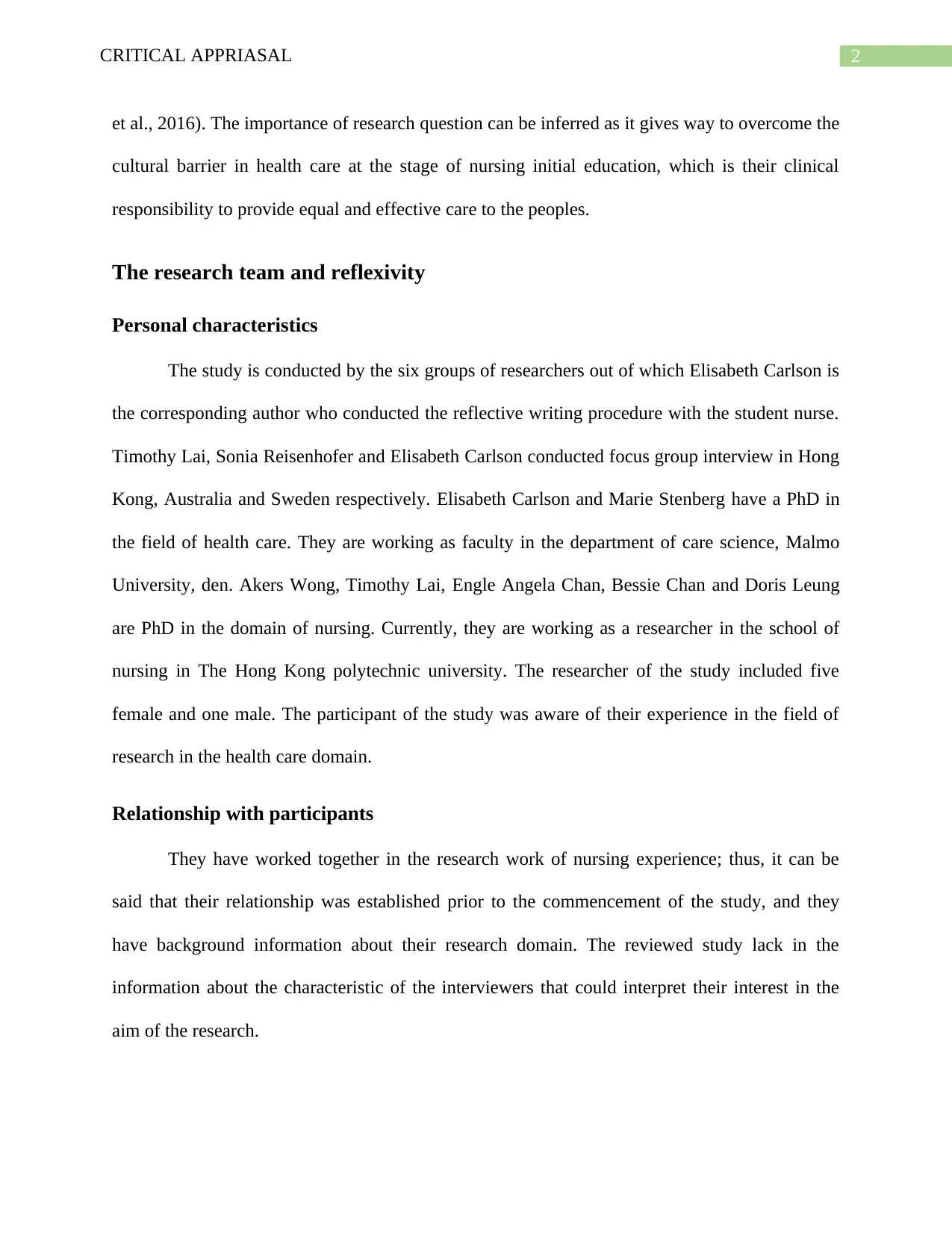
2CRITICAL APPRIASAL
et al., 2016). The importance of research question can be inferred as it gives way to overcome the
cultural barrier in health care at the stage of nursing initial education, which is their clinical
responsibility to provide equal and effective care to the peoples.
The research team and reflexivity
Personal characteristics
The study is conducted by the six groups of researchers out of which Elisabeth Carlson is
the corresponding author who conducted the reflective writing procedure with the student nurse.
Timothy Lai, Sonia Reisenhofer and Elisabeth Carlson conducted focus group interview in Hong
Kong, Australia and Sweden respectively. Elisabeth Carlson and Marie Stenberg have a PhD in
the field of health care. They are working as faculty in the department of care science, Malmo
University, den. Akers Wong, Timothy Lai, Engle Angela Chan, Bessie Chan and Doris Leung
are PhD in the domain of nursing. Currently, they are working as a researcher in the school of
nursing in The Hong Kong polytechnic university. The researcher of the study included five
female and one male. The participant of the study was aware of their experience in the field of
research in the health care domain.
Relationship with participants
They have worked together in the research work of nursing experience; thus, it can be
said that their relationship was established prior to the commencement of the study, and they
have background information about their research domain. The reviewed study lack in the
information about the characteristic of the interviewers that could interpret their interest in the
aim of the research.
et al., 2016). The importance of research question can be inferred as it gives way to overcome the
cultural barrier in health care at the stage of nursing initial education, which is their clinical
responsibility to provide equal and effective care to the peoples.
The research team and reflexivity
Personal characteristics
The study is conducted by the six groups of researchers out of which Elisabeth Carlson is
the corresponding author who conducted the reflective writing procedure with the student nurse.
Timothy Lai, Sonia Reisenhofer and Elisabeth Carlson conducted focus group interview in Hong
Kong, Australia and Sweden respectively. Elisabeth Carlson and Marie Stenberg have a PhD in
the field of health care. They are working as faculty in the department of care science, Malmo
University, den. Akers Wong, Timothy Lai, Engle Angela Chan, Bessie Chan and Doris Leung
are PhD in the domain of nursing. Currently, they are working as a researcher in the school of
nursing in The Hong Kong polytechnic university. The researcher of the study included five
female and one male. The participant of the study was aware of their experience in the field of
research in the health care domain.
Relationship with participants
They have worked together in the research work of nursing experience; thus, it can be
said that their relationship was established prior to the commencement of the study, and they
have background information about their research domain. The reviewed study lack in the
information about the characteristic of the interviewers that could interpret their interest in the
aim of the research.
⊘ This is a preview!⊘
Do you want full access?
Subscribe today to unlock all pages.

Trusted by 1+ million students worldwide
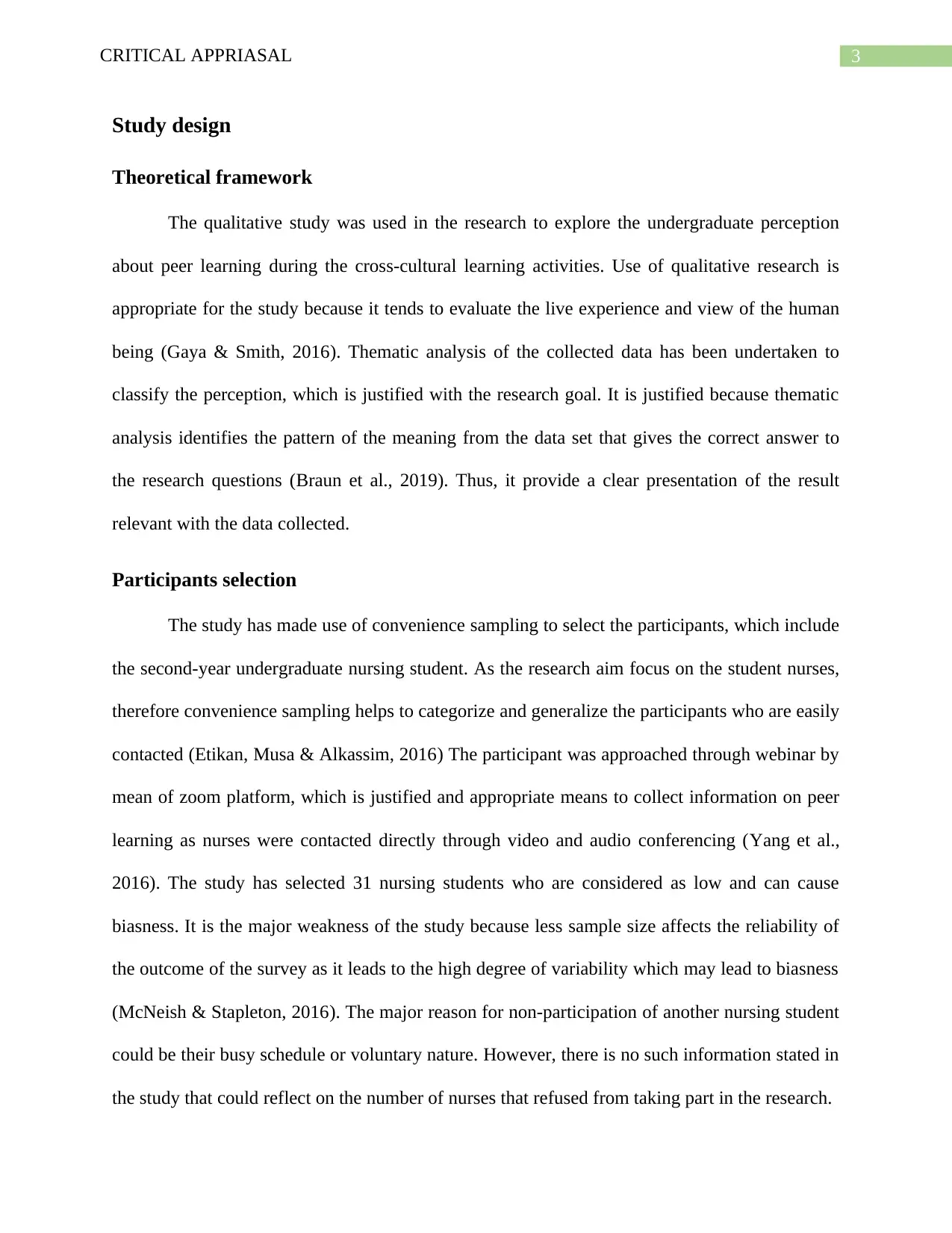
3CRITICAL APPRIASAL
Study design
Theoretical framework
The qualitative study was used in the research to explore the undergraduate perception
about peer learning during the cross-cultural learning activities. Use of qualitative research is
appropriate for the study because it tends to evaluate the live experience and view of the human
being (Gaya & Smith, 2016). Thematic analysis of the collected data has been undertaken to
classify the perception, which is justified with the research goal. It is justified because thematic
analysis identifies the pattern of the meaning from the data set that gives the correct answer to
the research questions (Braun et al., 2019). Thus, it provide a clear presentation of the result
relevant with the data collected.
Participants selection
The study has made use of convenience sampling to select the participants, which include
the second-year undergraduate nursing student. As the research aim focus on the student nurses,
therefore convenience sampling helps to categorize and generalize the participants who are easily
contacted (Etikan, Musa & Alkassim, 2016) The participant was approached through webinar by
mean of zoom platform, which is justified and appropriate means to collect information on peer
learning as nurses were contacted directly through video and audio conferencing (Yang et al.,
2016). The study has selected 31 nursing students who are considered as low and can cause
biasness. It is the major weakness of the study because less sample size affects the reliability of
the outcome of the survey as it leads to the high degree of variability which may lead to biasness
(McNeish & Stapleton, 2016). The major reason for non-participation of another nursing student
could be their busy schedule or voluntary nature. However, there is no such information stated in
the study that could reflect on the number of nurses that refused from taking part in the research.
Study design
Theoretical framework
The qualitative study was used in the research to explore the undergraduate perception
about peer learning during the cross-cultural learning activities. Use of qualitative research is
appropriate for the study because it tends to evaluate the live experience and view of the human
being (Gaya & Smith, 2016). Thematic analysis of the collected data has been undertaken to
classify the perception, which is justified with the research goal. It is justified because thematic
analysis identifies the pattern of the meaning from the data set that gives the correct answer to
the research questions (Braun et al., 2019). Thus, it provide a clear presentation of the result
relevant with the data collected.
Participants selection
The study has made use of convenience sampling to select the participants, which include
the second-year undergraduate nursing student. As the research aim focus on the student nurses,
therefore convenience sampling helps to categorize and generalize the participants who are easily
contacted (Etikan, Musa & Alkassim, 2016) The participant was approached through webinar by
mean of zoom platform, which is justified and appropriate means to collect information on peer
learning as nurses were contacted directly through video and audio conferencing (Yang et al.,
2016). The study has selected 31 nursing students who are considered as low and can cause
biasness. It is the major weakness of the study because less sample size affects the reliability of
the outcome of the survey as it leads to the high degree of variability which may lead to biasness
(McNeish & Stapleton, 2016). The major reason for non-participation of another nursing student
could be their busy schedule or voluntary nature. However, there is no such information stated in
the study that could reflect on the number of nurses that refused from taking part in the research.
Paraphrase This Document
Need a fresh take? Get an instant paraphrase of this document with our AI Paraphraser
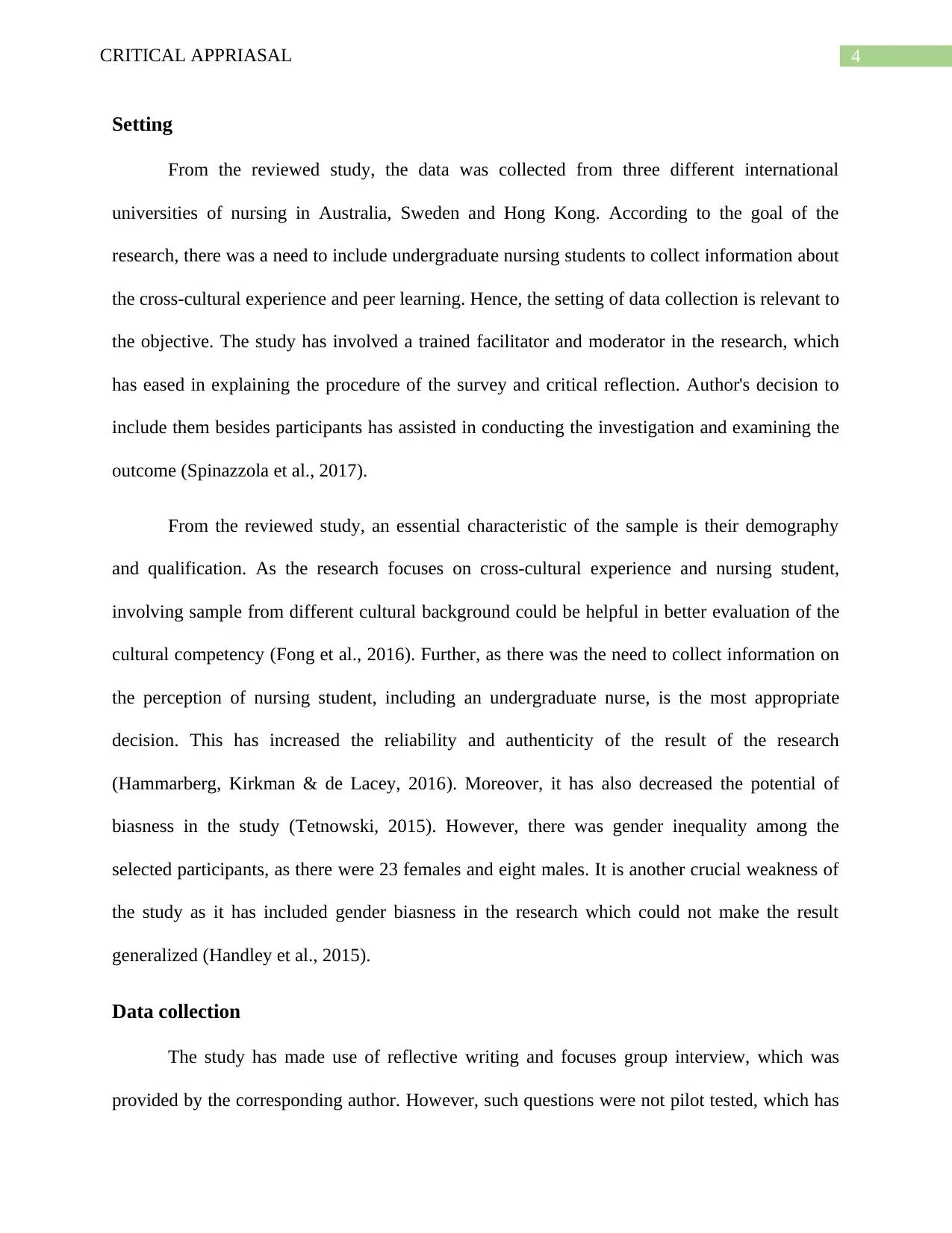
4CRITICAL APPRIASAL
Setting
From the reviewed study, the data was collected from three different international
universities of nursing in Australia, Sweden and Hong Kong. According to the goal of the
research, there was a need to include undergraduate nursing students to collect information about
the cross-cultural experience and peer learning. Hence, the setting of data collection is relevant to
the objective. The study has involved a trained facilitator and moderator in the research, which
has eased in explaining the procedure of the survey and critical reflection. Author's decision to
include them besides participants has assisted in conducting the investigation and examining the
outcome (Spinazzola et al., 2017).
From the reviewed study, an essential characteristic of the sample is their demography
and qualification. As the research focuses on cross-cultural experience and nursing student,
involving sample from different cultural background could be helpful in better evaluation of the
cultural competency (Fong et al., 2016). Further, as there was the need to collect information on
the perception of nursing student, including an undergraduate nurse, is the most appropriate
decision. This has increased the reliability and authenticity of the result of the research
(Hammarberg, Kirkman & de Lacey, 2016). Moreover, it has also decreased the potential of
biasness in the study (Tetnowski, 2015). However, there was gender inequality among the
selected participants, as there were 23 females and eight males. It is another crucial weakness of
the study as it has included gender biasness in the research which could not make the result
generalized (Handley et al., 2015).
Data collection
The study has made use of reflective writing and focuses group interview, which was
provided by the corresponding author. However, such questions were not pilot tested, which has
Setting
From the reviewed study, the data was collected from three different international
universities of nursing in Australia, Sweden and Hong Kong. According to the goal of the
research, there was a need to include undergraduate nursing students to collect information about
the cross-cultural experience and peer learning. Hence, the setting of data collection is relevant to
the objective. The study has involved a trained facilitator and moderator in the research, which
has eased in explaining the procedure of the survey and critical reflection. Author's decision to
include them besides participants has assisted in conducting the investigation and examining the
outcome (Spinazzola et al., 2017).
From the reviewed study, an essential characteristic of the sample is their demography
and qualification. As the research focuses on cross-cultural experience and nursing student,
involving sample from different cultural background could be helpful in better evaluation of the
cultural competency (Fong et al., 2016). Further, as there was the need to collect information on
the perception of nursing student, including an undergraduate nurse, is the most appropriate
decision. This has increased the reliability and authenticity of the result of the research
(Hammarberg, Kirkman & de Lacey, 2016). Moreover, it has also decreased the potential of
biasness in the study (Tetnowski, 2015). However, there was gender inequality among the
selected participants, as there were 23 females and eight males. It is another crucial weakness of
the study as it has included gender biasness in the research which could not make the result
generalized (Handley et al., 2015).
Data collection
The study has made use of reflective writing and focuses group interview, which was
provided by the corresponding author. However, such questions were not pilot tested, which has
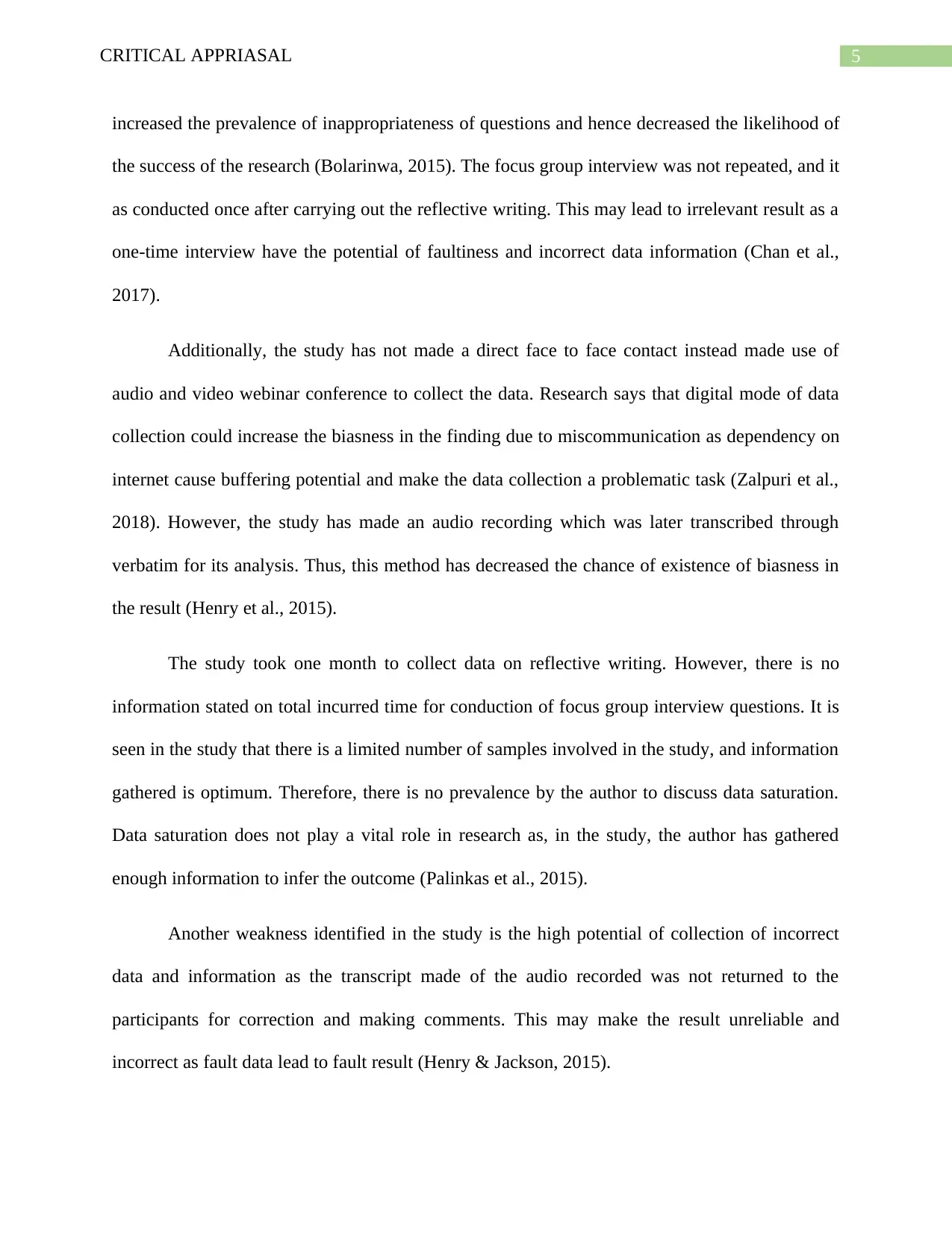
5CRITICAL APPRIASAL
increased the prevalence of inappropriateness of questions and hence decreased the likelihood of
the success of the research (Bolarinwa, 2015). The focus group interview was not repeated, and it
as conducted once after carrying out the reflective writing. This may lead to irrelevant result as a
one-time interview have the potential of faultiness and incorrect data information (Chan et al.,
2017).
Additionally, the study has not made a direct face to face contact instead made use of
audio and video webinar conference to collect the data. Research says that digital mode of data
collection could increase the biasness in the finding due to miscommunication as dependency on
internet cause buffering potential and make the data collection a problematic task (Zalpuri et al.,
2018). However, the study has made an audio recording which was later transcribed through
verbatim for its analysis. Thus, this method has decreased the chance of existence of biasness in
the result (Henry et al., 2015).
The study took one month to collect data on reflective writing. However, there is no
information stated on total incurred time for conduction of focus group interview questions. It is
seen in the study that there is a limited number of samples involved in the study, and information
gathered is optimum. Therefore, there is no prevalence by the author to discuss data saturation.
Data saturation does not play a vital role in research as, in the study, the author has gathered
enough information to infer the outcome (Palinkas et al., 2015).
Another weakness identified in the study is the high potential of collection of incorrect
data and information as the transcript made of the audio recorded was not returned to the
participants for correction and making comments. This may make the result unreliable and
incorrect as fault data lead to fault result (Henry & Jackson, 2015).
increased the prevalence of inappropriateness of questions and hence decreased the likelihood of
the success of the research (Bolarinwa, 2015). The focus group interview was not repeated, and it
as conducted once after carrying out the reflective writing. This may lead to irrelevant result as a
one-time interview have the potential of faultiness and incorrect data information (Chan et al.,
2017).
Additionally, the study has not made a direct face to face contact instead made use of
audio and video webinar conference to collect the data. Research says that digital mode of data
collection could increase the biasness in the finding due to miscommunication as dependency on
internet cause buffering potential and make the data collection a problematic task (Zalpuri et al.,
2018). However, the study has made an audio recording which was later transcribed through
verbatim for its analysis. Thus, this method has decreased the chance of existence of biasness in
the result (Henry et al., 2015).
The study took one month to collect data on reflective writing. However, there is no
information stated on total incurred time for conduction of focus group interview questions. It is
seen in the study that there is a limited number of samples involved in the study, and information
gathered is optimum. Therefore, there is no prevalence by the author to discuss data saturation.
Data saturation does not play a vital role in research as, in the study, the author has gathered
enough information to infer the outcome (Palinkas et al., 2015).
Another weakness identified in the study is the high potential of collection of incorrect
data and information as the transcript made of the audio recorded was not returned to the
participants for correction and making comments. This may make the result unreliable and
incorrect as fault data lead to fault result (Henry & Jackson, 2015).
⊘ This is a preview!⊘
Do you want full access?
Subscribe today to unlock all pages.

Trusted by 1+ million students worldwide
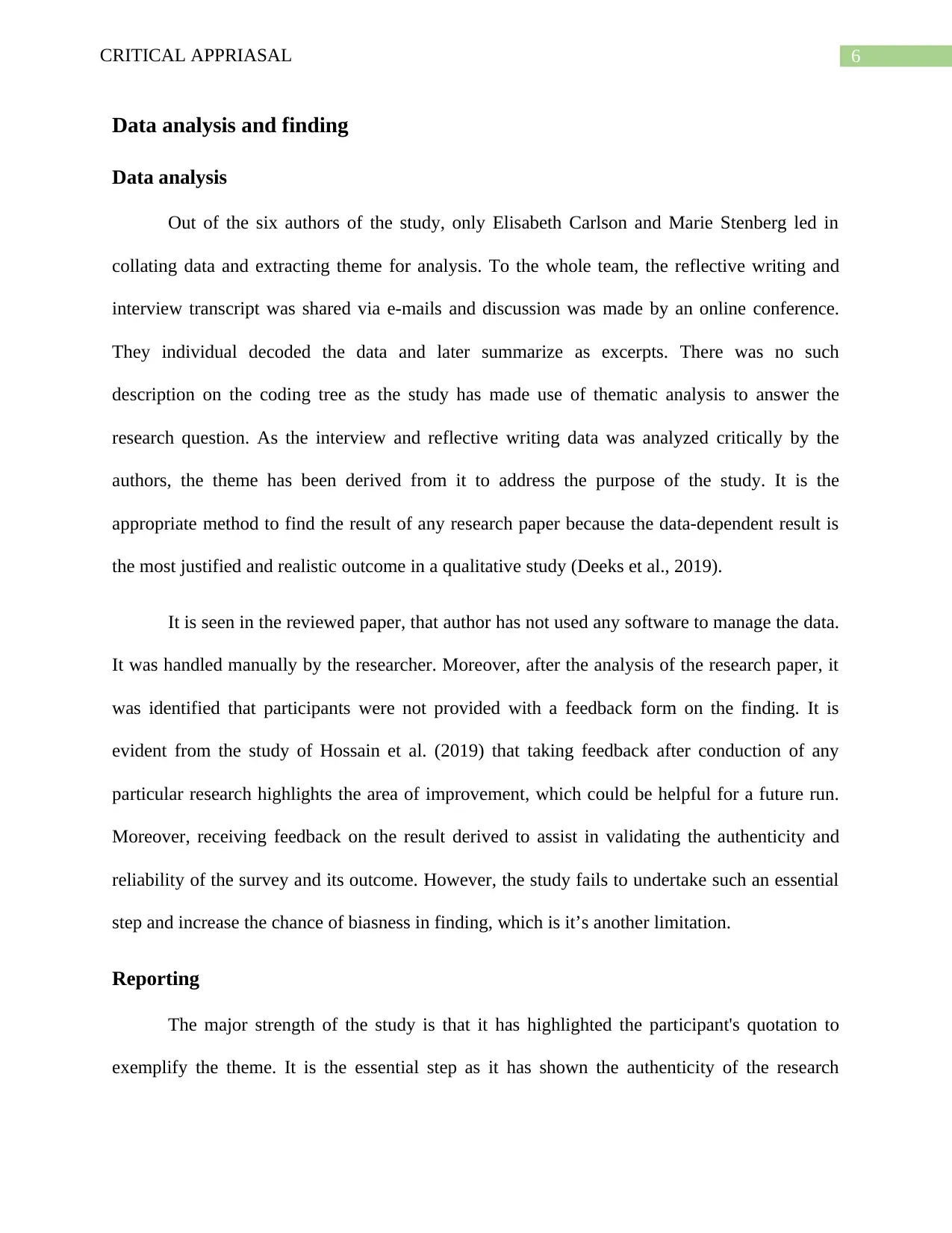
6CRITICAL APPRIASAL
Data analysis and finding
Data analysis
Out of the six authors of the study, only Elisabeth Carlson and Marie Stenberg led in
collating data and extracting theme for analysis. To the whole team, the reflective writing and
interview transcript was shared via e-mails and discussion was made by an online conference.
They individual decoded the data and later summarize as excerpts. There was no such
description on the coding tree as the study has made use of thematic analysis to answer the
research question. As the interview and reflective writing data was analyzed critically by the
authors, the theme has been derived from it to address the purpose of the study. It is the
appropriate method to find the result of any research paper because the data-dependent result is
the most justified and realistic outcome in a qualitative study (Deeks et al., 2019).
It is seen in the reviewed paper, that author has not used any software to manage the data.
It was handled manually by the researcher. Moreover, after the analysis of the research paper, it
was identified that participants were not provided with a feedback form on the finding. It is
evident from the study of Hossain et al. (2019) that taking feedback after conduction of any
particular research highlights the area of improvement, which could be helpful for a future run.
Moreover, receiving feedback on the result derived to assist in validating the authenticity and
reliability of the survey and its outcome. However, the study fails to undertake such an essential
step and increase the chance of biasness in finding, which is it’s another limitation.
Reporting
The major strength of the study is that it has highlighted the participant's quotation to
exemplify the theme. It is the essential step as it has shown the authenticity of the research
Data analysis and finding
Data analysis
Out of the six authors of the study, only Elisabeth Carlson and Marie Stenberg led in
collating data and extracting theme for analysis. To the whole team, the reflective writing and
interview transcript was shared via e-mails and discussion was made by an online conference.
They individual decoded the data and later summarize as excerpts. There was no such
description on the coding tree as the study has made use of thematic analysis to answer the
research question. As the interview and reflective writing data was analyzed critically by the
authors, the theme has been derived from it to address the purpose of the study. It is the
appropriate method to find the result of any research paper because the data-dependent result is
the most justified and realistic outcome in a qualitative study (Deeks et al., 2019).
It is seen in the reviewed paper, that author has not used any software to manage the data.
It was handled manually by the researcher. Moreover, after the analysis of the research paper, it
was identified that participants were not provided with a feedback form on the finding. It is
evident from the study of Hossain et al. (2019) that taking feedback after conduction of any
particular research highlights the area of improvement, which could be helpful for a future run.
Moreover, receiving feedback on the result derived to assist in validating the authenticity and
reliability of the survey and its outcome. However, the study fails to undertake such an essential
step and increase the chance of biasness in finding, which is it’s another limitation.
Reporting
The major strength of the study is that it has highlighted the participant's quotation to
exemplify the theme. It is the essential step as it has shown the authenticity of the research
Paraphrase This Document
Need a fresh take? Get an instant paraphrase of this document with our AI Paraphraser
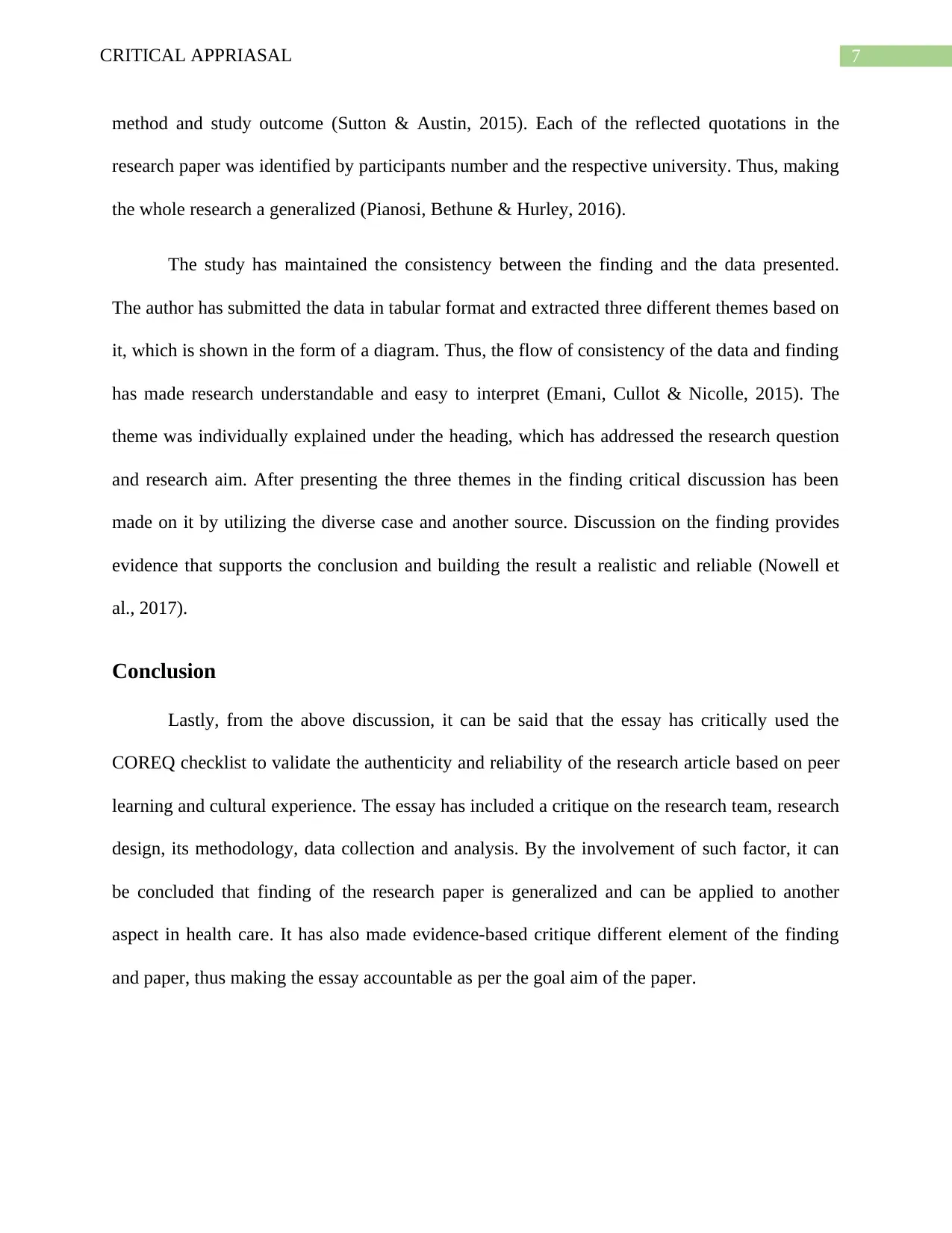
7CRITICAL APPRIASAL
method and study outcome (Sutton & Austin, 2015). Each of the reflected quotations in the
research paper was identified by participants number and the respective university. Thus, making
the whole research a generalized (Pianosi, Bethune & Hurley, 2016).
The study has maintained the consistency between the finding and the data presented.
The author has submitted the data in tabular format and extracted three different themes based on
it, which is shown in the form of a diagram. Thus, the flow of consistency of the data and finding
has made research understandable and easy to interpret (Emani, Cullot & Nicolle, 2015). The
theme was individually explained under the heading, which has addressed the research question
and research aim. After presenting the three themes in the finding critical discussion has been
made on it by utilizing the diverse case and another source. Discussion on the finding provides
evidence that supports the conclusion and building the result a realistic and reliable (Nowell et
al., 2017).
Conclusion
Lastly, from the above discussion, it can be said that the essay has critically used the
COREQ checklist to validate the authenticity and reliability of the research article based on peer
learning and cultural experience. The essay has included a critique on the research team, research
design, its methodology, data collection and analysis. By the involvement of such factor, it can
be concluded that finding of the research paper is generalized and can be applied to another
aspect in health care. It has also made evidence-based critique different element of the finding
and paper, thus making the essay accountable as per the goal aim of the paper.
method and study outcome (Sutton & Austin, 2015). Each of the reflected quotations in the
research paper was identified by participants number and the respective university. Thus, making
the whole research a generalized (Pianosi, Bethune & Hurley, 2016).
The study has maintained the consistency between the finding and the data presented.
The author has submitted the data in tabular format and extracted three different themes based on
it, which is shown in the form of a diagram. Thus, the flow of consistency of the data and finding
has made research understandable and easy to interpret (Emani, Cullot & Nicolle, 2015). The
theme was individually explained under the heading, which has addressed the research question
and research aim. After presenting the three themes in the finding critical discussion has been
made on it by utilizing the diverse case and another source. Discussion on the finding provides
evidence that supports the conclusion and building the result a realistic and reliable (Nowell et
al., 2017).
Conclusion
Lastly, from the above discussion, it can be said that the essay has critically used the
COREQ checklist to validate the authenticity and reliability of the research article based on peer
learning and cultural experience. The essay has included a critique on the research team, research
design, its methodology, data collection and analysis. By the involvement of such factor, it can
be concluded that finding of the research paper is generalized and can be applied to another
aspect in health care. It has also made evidence-based critique different element of the finding
and paper, thus making the essay accountable as per the goal aim of the paper.
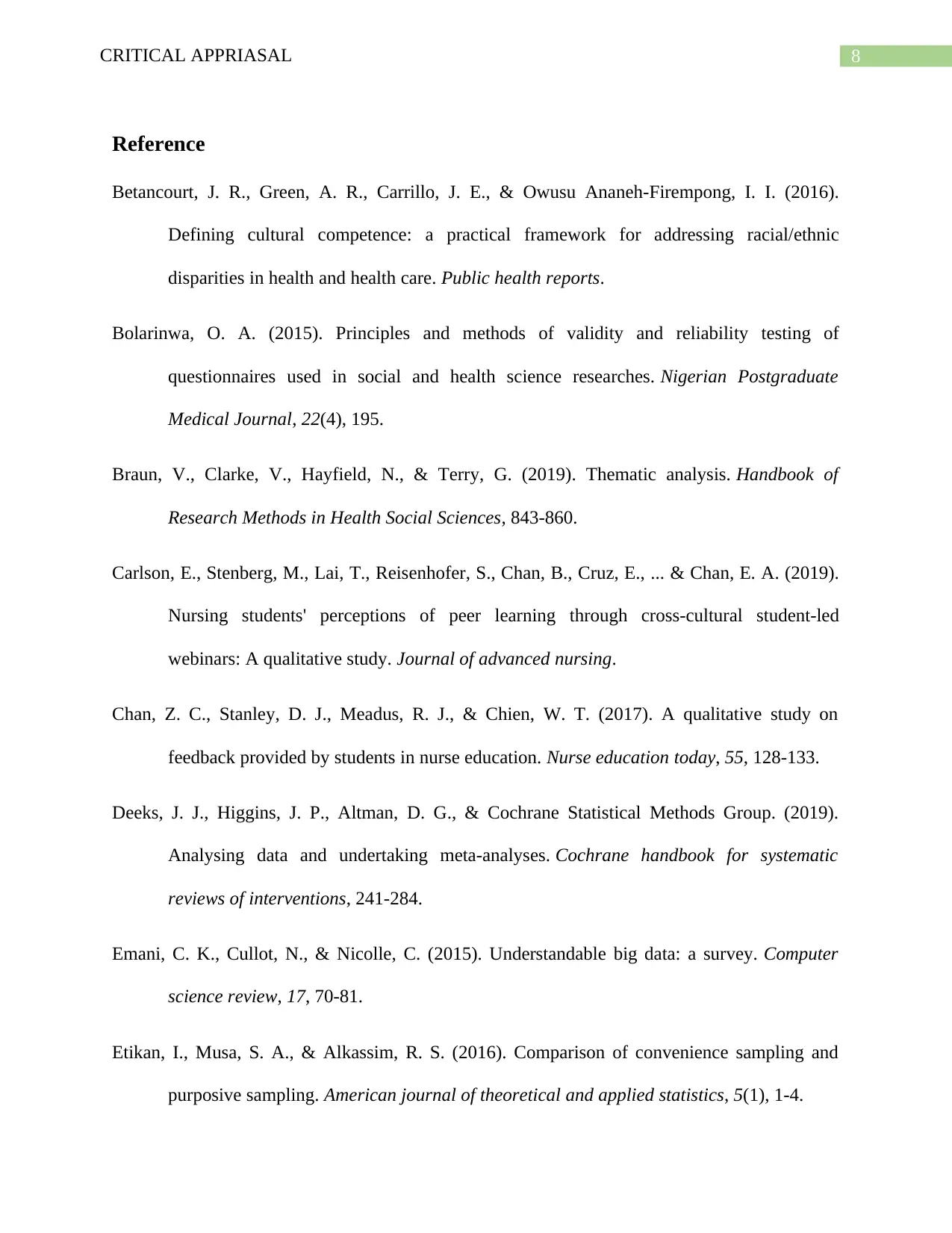
8CRITICAL APPRIASAL
Reference
Betancourt, J. R., Green, A. R., Carrillo, J. E., & Owusu Ananeh-Firempong, I. I. (2016).
Defining cultural competence: a practical framework for addressing racial/ethnic
disparities in health and health care. Public health reports.
Bolarinwa, O. A. (2015). Principles and methods of validity and reliability testing of
questionnaires used in social and health science researches. Nigerian Postgraduate
Medical Journal, 22(4), 195.
Braun, V., Clarke, V., Hayfield, N., & Terry, G. (2019). Thematic analysis. Handbook of
Research Methods in Health Social Sciences, 843-860.
Carlson, E., Stenberg, M., Lai, T., Reisenhofer, S., Chan, B., Cruz, E., ... & Chan, E. A. (2019).
Nursing students' perceptions of peer learning through cross‐cultural student‐led
webinars: A qualitative study. Journal of advanced nursing.
Chan, Z. C., Stanley, D. J., Meadus, R. J., & Chien, W. T. (2017). A qualitative study on
feedback provided by students in nurse education. Nurse education today, 55, 128-133.
Deeks, J. J., Higgins, J. P., Altman, D. G., & Cochrane Statistical Methods Group. (2019).
Analysing data and undertaking meta‐analyses. Cochrane handbook for systematic
reviews of interventions, 241-284.
Emani, C. K., Cullot, N., & Nicolle, C. (2015). Understandable big data: a survey. Computer
science review, 17, 70-81.
Etikan, I., Musa, S. A., & Alkassim, R. S. (2016). Comparison of convenience sampling and
purposive sampling. American journal of theoretical and applied statistics, 5(1), 1-4.
Reference
Betancourt, J. R., Green, A. R., Carrillo, J. E., & Owusu Ananeh-Firempong, I. I. (2016).
Defining cultural competence: a practical framework for addressing racial/ethnic
disparities in health and health care. Public health reports.
Bolarinwa, O. A. (2015). Principles and methods of validity and reliability testing of
questionnaires used in social and health science researches. Nigerian Postgraduate
Medical Journal, 22(4), 195.
Braun, V., Clarke, V., Hayfield, N., & Terry, G. (2019). Thematic analysis. Handbook of
Research Methods in Health Social Sciences, 843-860.
Carlson, E., Stenberg, M., Lai, T., Reisenhofer, S., Chan, B., Cruz, E., ... & Chan, E. A. (2019).
Nursing students' perceptions of peer learning through cross‐cultural student‐led
webinars: A qualitative study. Journal of advanced nursing.
Chan, Z. C., Stanley, D. J., Meadus, R. J., & Chien, W. T. (2017). A qualitative study on
feedback provided by students in nurse education. Nurse education today, 55, 128-133.
Deeks, J. J., Higgins, J. P., Altman, D. G., & Cochrane Statistical Methods Group. (2019).
Analysing data and undertaking meta‐analyses. Cochrane handbook for systematic
reviews of interventions, 241-284.
Emani, C. K., Cullot, N., & Nicolle, C. (2015). Understandable big data: a survey. Computer
science review, 17, 70-81.
Etikan, I., Musa, S. A., & Alkassim, R. S. (2016). Comparison of convenience sampling and
purposive sampling. American journal of theoretical and applied statistics, 5(1), 1-4.
⊘ This is a preview!⊘
Do you want full access?
Subscribe today to unlock all pages.

Trusted by 1+ million students worldwide
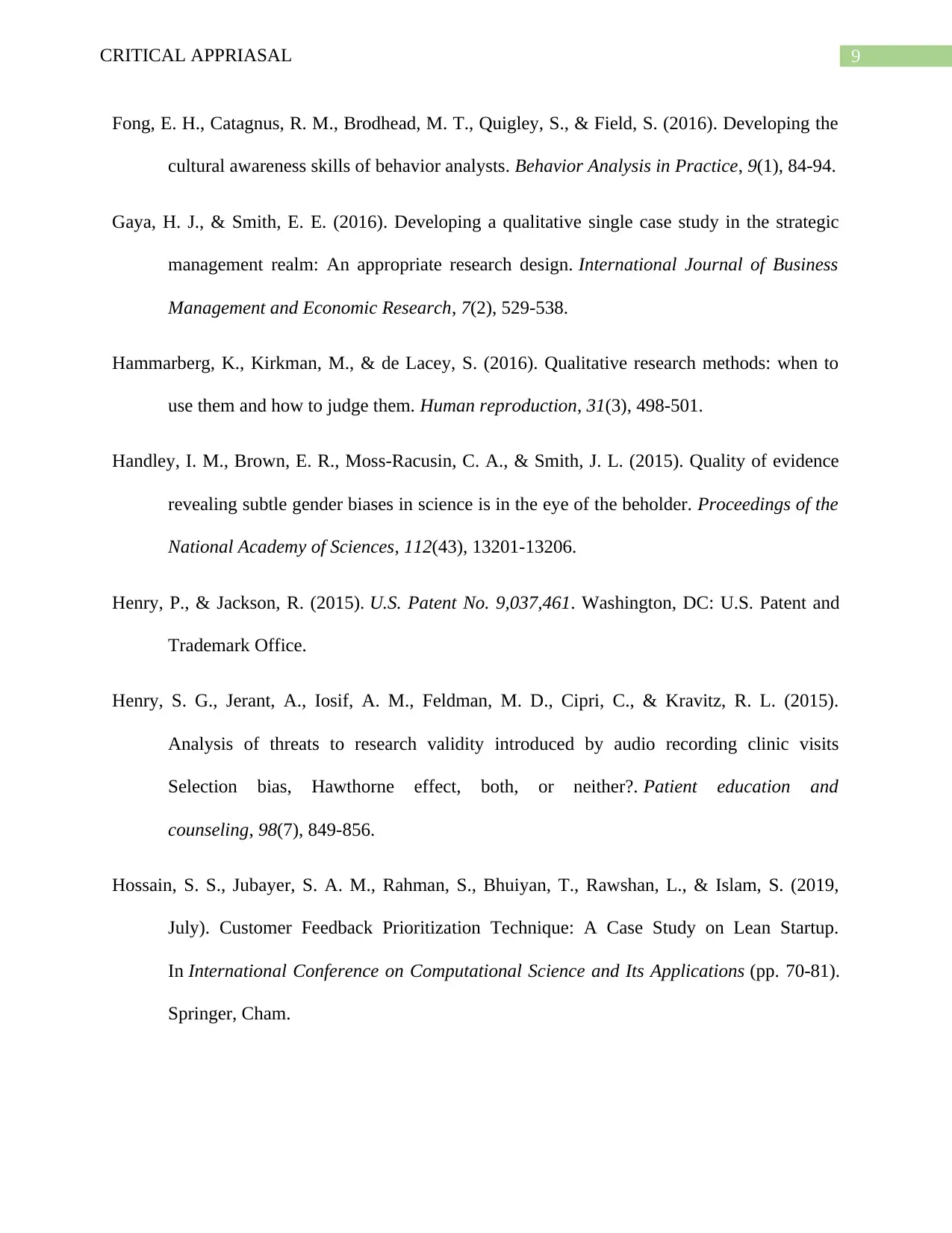
9CRITICAL APPRIASAL
Fong, E. H., Catagnus, R. M., Brodhead, M. T., Quigley, S., & Field, S. (2016). Developing the
cultural awareness skills of behavior analysts. Behavior Analysis in Practice, 9(1), 84-94.
Gaya, H. J., & Smith, E. E. (2016). Developing a qualitative single case study in the strategic
management realm: An appropriate research design. International Journal of Business
Management and Economic Research, 7(2), 529-538.
Hammarberg, K., Kirkman, M., & de Lacey, S. (2016). Qualitative research methods: when to
use them and how to judge them. Human reproduction, 31(3), 498-501.
Handley, I. M., Brown, E. R., Moss-Racusin, C. A., & Smith, J. L. (2015). Quality of evidence
revealing subtle gender biases in science is in the eye of the beholder. Proceedings of the
National Academy of Sciences, 112(43), 13201-13206.
Henry, P., & Jackson, R. (2015). U.S. Patent No. 9,037,461. Washington, DC: U.S. Patent and
Trademark Office.
Henry, S. G., Jerant, A., Iosif, A. M., Feldman, M. D., Cipri, C., & Kravitz, R. L. (2015).
Analysis of threats to research validity introduced by audio recording clinic visits
Selection bias, Hawthorne effect, both, or neither?. Patient education and
counseling, 98(7), 849-856.
Hossain, S. S., Jubayer, S. A. M., Rahman, S., Bhuiyan, T., Rawshan, L., & Islam, S. (2019,
July). Customer Feedback Prioritization Technique: A Case Study on Lean Startup.
In International Conference on Computational Science and Its Applications (pp. 70-81).
Springer, Cham.
Fong, E. H., Catagnus, R. M., Brodhead, M. T., Quigley, S., & Field, S. (2016). Developing the
cultural awareness skills of behavior analysts. Behavior Analysis in Practice, 9(1), 84-94.
Gaya, H. J., & Smith, E. E. (2016). Developing a qualitative single case study in the strategic
management realm: An appropriate research design. International Journal of Business
Management and Economic Research, 7(2), 529-538.
Hammarberg, K., Kirkman, M., & de Lacey, S. (2016). Qualitative research methods: when to
use them and how to judge them. Human reproduction, 31(3), 498-501.
Handley, I. M., Brown, E. R., Moss-Racusin, C. A., & Smith, J. L. (2015). Quality of evidence
revealing subtle gender biases in science is in the eye of the beholder. Proceedings of the
National Academy of Sciences, 112(43), 13201-13206.
Henry, P., & Jackson, R. (2015). U.S. Patent No. 9,037,461. Washington, DC: U.S. Patent and
Trademark Office.
Henry, S. G., Jerant, A., Iosif, A. M., Feldman, M. D., Cipri, C., & Kravitz, R. L. (2015).
Analysis of threats to research validity introduced by audio recording clinic visits
Selection bias, Hawthorne effect, both, or neither?. Patient education and
counseling, 98(7), 849-856.
Hossain, S. S., Jubayer, S. A. M., Rahman, S., Bhuiyan, T., Rawshan, L., & Islam, S. (2019,
July). Customer Feedback Prioritization Technique: A Case Study on Lean Startup.
In International Conference on Computational Science and Its Applications (pp. 70-81).
Springer, Cham.
Paraphrase This Document
Need a fresh take? Get an instant paraphrase of this document with our AI Paraphraser
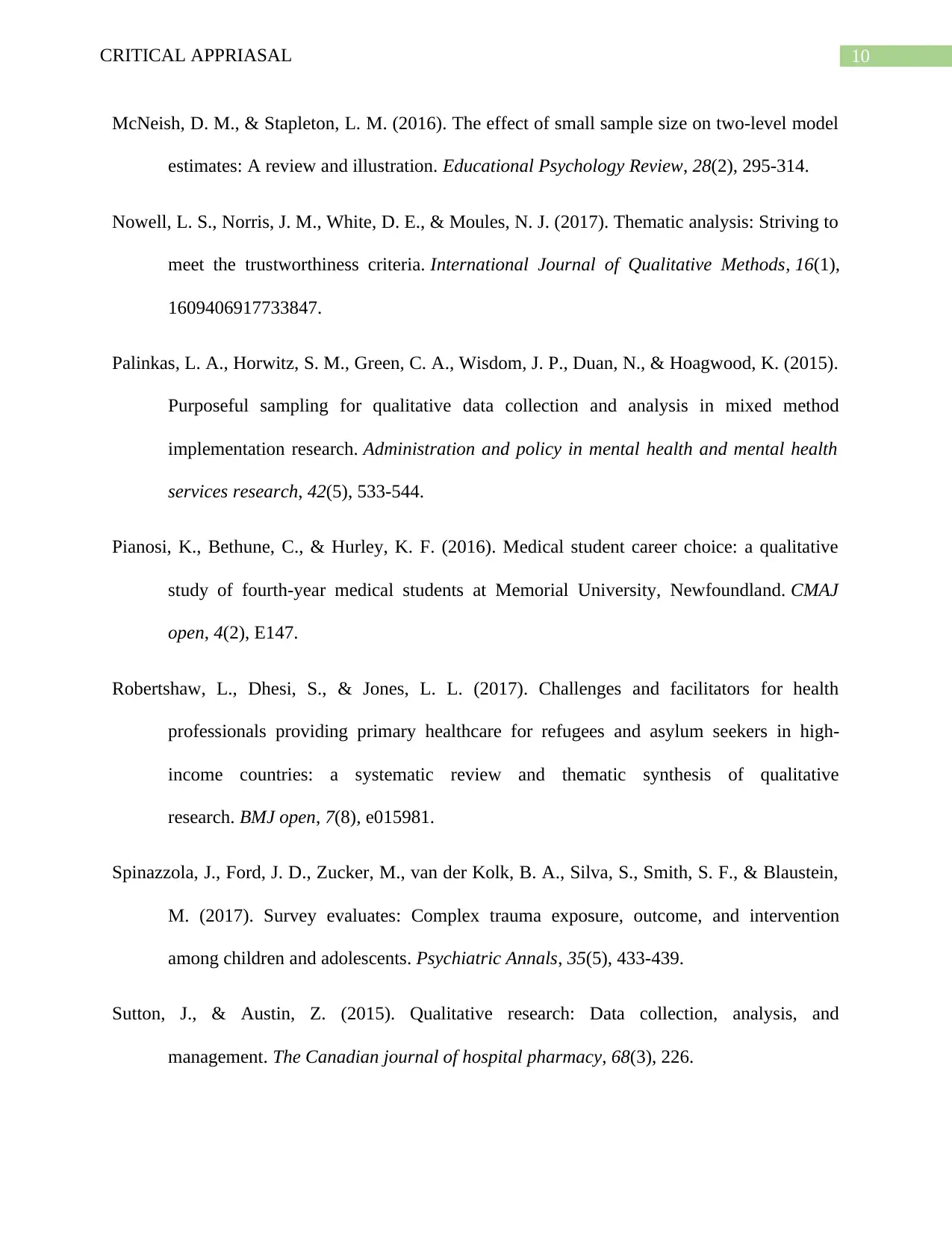
10CRITICAL APPRIASAL
McNeish, D. M., & Stapleton, L. M. (2016). The effect of small sample size on two-level model
estimates: A review and illustration. Educational Psychology Review, 28(2), 295-314.
Nowell, L. S., Norris, J. M., White, D. E., & Moules, N. J. (2017). Thematic analysis: Striving to
meet the trustworthiness criteria. International Journal of Qualitative Methods, 16(1),
1609406917733847.
Palinkas, L. A., Horwitz, S. M., Green, C. A., Wisdom, J. P., Duan, N., & Hoagwood, K. (2015).
Purposeful sampling for qualitative data collection and analysis in mixed method
implementation research. Administration and policy in mental health and mental health
services research, 42(5), 533-544.
Pianosi, K., Bethune, C., & Hurley, K. F. (2016). Medical student career choice: a qualitative
study of fourth-year medical students at Memorial University, Newfoundland. CMAJ
open, 4(2), E147.
Robertshaw, L., Dhesi, S., & Jones, L. L. (2017). Challenges and facilitators for health
professionals providing primary healthcare for refugees and asylum seekers in high-
income countries: a systematic review and thematic synthesis of qualitative
research. BMJ open, 7(8), e015981.
Spinazzola, J., Ford, J. D., Zucker, M., van der Kolk, B. A., Silva, S., Smith, S. F., & Blaustein,
M. (2017). Survey evaluates: Complex trauma exposure, outcome, and intervention
among children and adolescents. Psychiatric Annals, 35(5), 433-439.
Sutton, J., & Austin, Z. (2015). Qualitative research: Data collection, analysis, and
management. The Canadian journal of hospital pharmacy, 68(3), 226.
McNeish, D. M., & Stapleton, L. M. (2016). The effect of small sample size on two-level model
estimates: A review and illustration. Educational Psychology Review, 28(2), 295-314.
Nowell, L. S., Norris, J. M., White, D. E., & Moules, N. J. (2017). Thematic analysis: Striving to
meet the trustworthiness criteria. International Journal of Qualitative Methods, 16(1),
1609406917733847.
Palinkas, L. A., Horwitz, S. M., Green, C. A., Wisdom, J. P., Duan, N., & Hoagwood, K. (2015).
Purposeful sampling for qualitative data collection and analysis in mixed method
implementation research. Administration and policy in mental health and mental health
services research, 42(5), 533-544.
Pianosi, K., Bethune, C., & Hurley, K. F. (2016). Medical student career choice: a qualitative
study of fourth-year medical students at Memorial University, Newfoundland. CMAJ
open, 4(2), E147.
Robertshaw, L., Dhesi, S., & Jones, L. L. (2017). Challenges and facilitators for health
professionals providing primary healthcare for refugees and asylum seekers in high-
income countries: a systematic review and thematic synthesis of qualitative
research. BMJ open, 7(8), e015981.
Spinazzola, J., Ford, J. D., Zucker, M., van der Kolk, B. A., Silva, S., Smith, S. F., & Blaustein,
M. (2017). Survey evaluates: Complex trauma exposure, outcome, and intervention
among children and adolescents. Psychiatric Annals, 35(5), 433-439.
Sutton, J., & Austin, Z. (2015). Qualitative research: Data collection, analysis, and
management. The Canadian journal of hospital pharmacy, 68(3), 226.
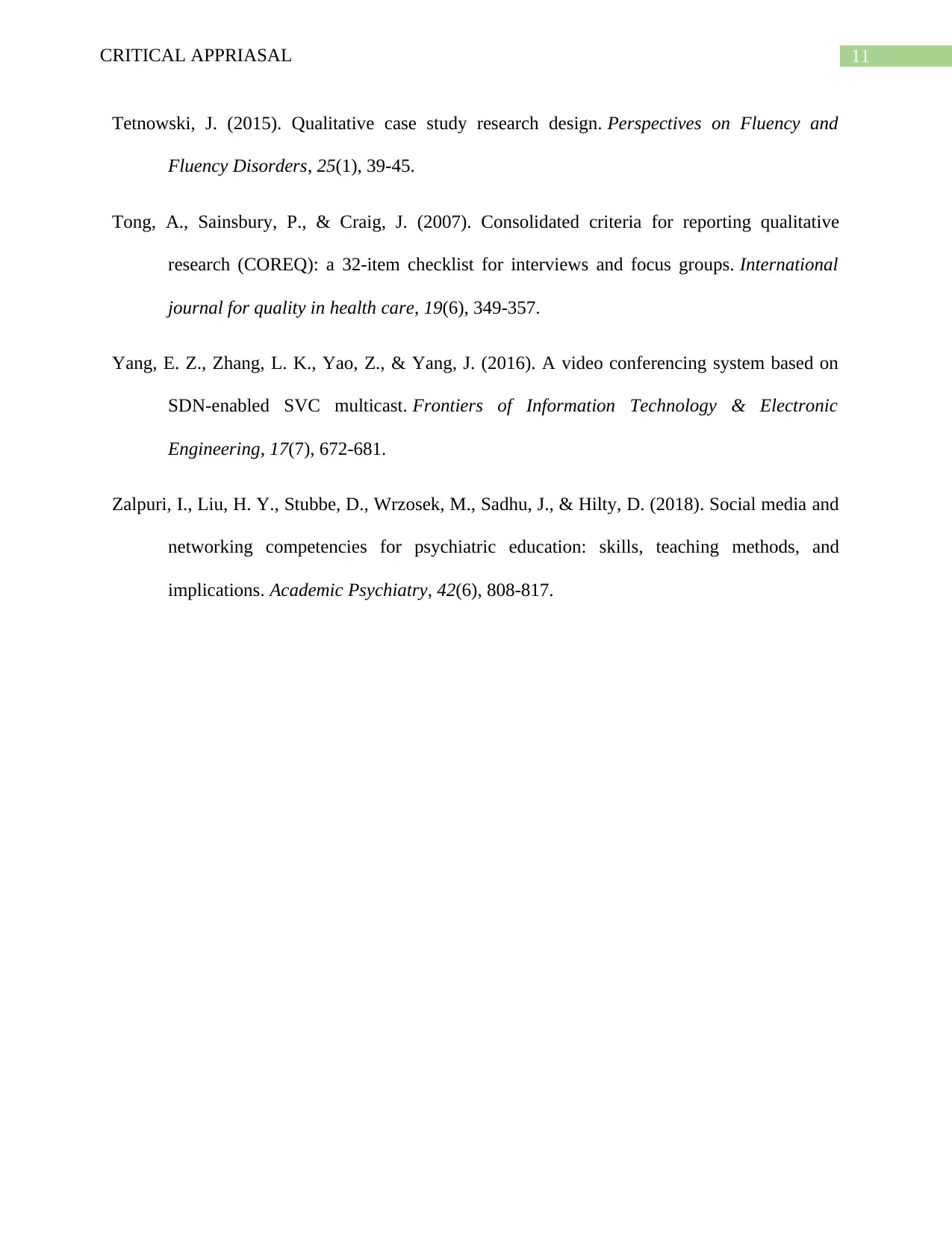
11CRITICAL APPRIASAL
Tetnowski, J. (2015). Qualitative case study research design. Perspectives on Fluency and
Fluency Disorders, 25(1), 39-45.
Tong, A., Sainsbury, P., & Craig, J. (2007). Consolidated criteria for reporting qualitative
research (COREQ): a 32-item checklist for interviews and focus groups. International
journal for quality in health care, 19(6), 349-357.
Yang, E. Z., Zhang, L. K., Yao, Z., & Yang, J. (2016). A video conferencing system based on
SDN-enabled SVC multicast. Frontiers of Information Technology & Electronic
Engineering, 17(7), 672-681.
Zalpuri, I., Liu, H. Y., Stubbe, D., Wrzosek, M., Sadhu, J., & Hilty, D. (2018). Social media and
networking competencies for psychiatric education: skills, teaching methods, and
implications. Academic Psychiatry, 42(6), 808-817.
Tetnowski, J. (2015). Qualitative case study research design. Perspectives on Fluency and
Fluency Disorders, 25(1), 39-45.
Tong, A., Sainsbury, P., & Craig, J. (2007). Consolidated criteria for reporting qualitative
research (COREQ): a 32-item checklist for interviews and focus groups. International
journal for quality in health care, 19(6), 349-357.
Yang, E. Z., Zhang, L. K., Yao, Z., & Yang, J. (2016). A video conferencing system based on
SDN-enabled SVC multicast. Frontiers of Information Technology & Electronic
Engineering, 17(7), 672-681.
Zalpuri, I., Liu, H. Y., Stubbe, D., Wrzosek, M., Sadhu, J., & Hilty, D. (2018). Social media and
networking competencies for psychiatric education: skills, teaching methods, and
implications. Academic Psychiatry, 42(6), 808-817.
⊘ This is a preview!⊘
Do you want full access?
Subscribe today to unlock all pages.

Trusted by 1+ million students worldwide
1 out of 12
Your All-in-One AI-Powered Toolkit for Academic Success.
+13062052269
info@desklib.com
Available 24*7 on WhatsApp / Email
![[object Object]](/_next/static/media/star-bottom.7253800d.svg)
Unlock your academic potential
Copyright © 2020–2025 A2Z Services. All Rights Reserved. Developed and managed by ZUCOL.